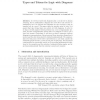Free Online Productivity Tools
i2Speak
i2Symbol
i2OCR
iTex2Img
iWeb2Print
iWeb2Shot
i2Type
iPdf2Split
iPdf2Merge
i2Bopomofo
i2Arabic
i2Style
i2Image
i2PDF
iLatex2Rtf
Sci2ools
127
click to vote
ICCS
2004
Springer
2004
Springer
Types and Tokens for Logic with Diagrams
It is well accepted that diagrams play a crucial role in human reasoning. But in mathematics, diagrams are most often only used for visualizations, but it is doubted that diagrams are rigor enough to play an essential role in a proof. This paper takes the opposite point of view: It is argued that rigor formal logic can carried out with diagrams. In order to do that, it is first analyzed which problems can occur in diagrammatic systems, and how a diagrammatic system has to be designed in order to get a rigor logic system. Particularly, it will turn out that a separation between diagrams as representations of structures and these structures themselves is needed, and the structures should be defined mathematically. The argumentation for this point of view will be embedded into a case study, namely the existential graphs of Peirce. In the second part of this paper, the theoretical considerations are practically carried out by providing mathematical definitions for the semantics and the ...
Diagrams | ICCS 2004 | Rigor | Rigor Formal Logic |
Related Content
| Added | 01 Jul 2010 |
| Updated | 01 Jul 2010 |
| Type | Conference |
| Year | 2004 |
| Where | ICCS |
| Authors | Frithjof Dau |
Comments (0)

